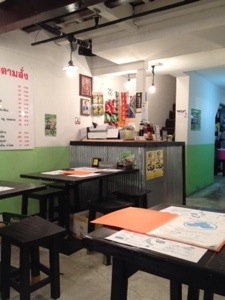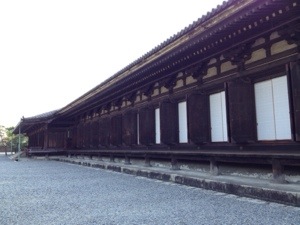I spent three nights in Kyoto and it wasn’t nearly enough time. This city is a really interesting blend of traditional and modern Japan. Wide boulevards funnel into tiny side streets with limited pedestrian access; department stores compete for the attention of shoppers with local markets selling all manners of goods; space age buildings are within walking distance of shrines and temples that are hundreds of years old; I have seen more people wearing kimonos here than in any other place in Japan!
For my money, these are some of my highlights and are well with seeing if you have limited time.
The Silver Pavilion

Yes, I know everyone raves about the Golden Pavilion, and yes it is wonderful, but I liked the Silver Pavilion more. There is a sense of grandeur as you arrive: the Philosopher’s Walk and its cherry trees welcome you almost to the entrance. The pavilion itself is original (unlike the Golden Pavilion, which was rebuilt in the 1950s after being burned down by a mad monk) but it has lost its black lacquer coating from which its name apparently derived (the reflection made the temple look silver). The garden is just lovely, with its raked sand, ponds, waterfalls, pines and cherry trees and moon mound. The view over Kyoto is just gorgeous.
Gion

Gion, also known as the geisha district, is such an interesting area to walk around, because you have immediate access to traditional Japan. This area still houses geishas, with the youngest being 15, and the oldest in her 80s. Some buildings have been converted to restaurants and residences. Apparently, it is very expensive area for anything, including eating out. Wandering around you see all sorts of good luck charms near doors and on roofs to protect inhabitants. Cars seem oddly out of place here: the area is a time capsule preserving a way of life that still manages to exist in today’s hustle and bustle.
Kyoto station

What an amazing building this is! Designed by architect Hiroshi Hara, it is like a stadium, with its space, light and steel. There are escalators which lead up to viewing platforms, passing restaurants and cafés and department stores along the way. There is a garden at the top on one side, a sculpture on the top at the other, with views over Kyoto. I spent an hour or so there, just taking photos.
(I must say that despite it’s beauty, this was the most difficult station to navigate. Tokyo and Shinjuku Stations were walks in the park compared to Kyoto Station. I found the signage confusing, and I kept having to backtrack. There were people everywhere and going in every direction, some were slow walkers, or just stopped dead in their tracks, so it became a bit of a obstacle course getting around them. I breathed a huge sigh of relief that I made it to Platform 31 in plenty of time for my train and was grateful I factored in over an hour to get myself to the correct spot.)
Shinto shrine and Buddhist temple

One of the fascinating things about Japanese culture is that the Japanese are both Shinto and Buddhist (and Christian at Christmas). It seems that worshipping both religions takes care of this life and the next. I visited a shrine and a temple while I was here. Both are worth seeing for different reasons: the Fushimi-inari Shrine is a Shinto shrine that has a 4km (although it seems endless) arcade of vermillion torii (shrine gates) that snakes through a densely wooded mountain. The Sanjūsangen-dō is a Buddhist temple that has a 118 metre hall filled with over 1000 life-size Buddhist statues. It is the longest wooden building in the world, apparently. The garden surrounding the temple was also quite lovely with its pond, rocks and cherry trees.

Visiting this castle was literally like taking a step back in time. The castle has an outer moat and an inner moat, beautiful gardens and a stunning entrance gate. It was fascinating to be able to walk around the inside of the castle via the nightingale floors (wooden floors that make a sound each time you take a step, sort of like an alarm system) and imagine what life was like in Japan at this time.
While the following aren’t sightseeing highlights, they creating added to my experience of this lovely city:
Ramen noodles

I had a guide for a day as part of my package, and I was assigned the delightful Ayako, who, as well as showing me some of the highlights of Kyoto, also took me to a ramen noodles restaurant for lunch. This were super yummy: the noodles were served in a thick miso broth, with cabbage, a boiled egg and pork. It was a rich and satisfying meal, and I was still full at dinner!
Feeling a rock star
Particularly at the Golden Pavilion, I had school children pointing to me and waving from their buses. I had kids practising their English (“Hello… how are you… where are you from!” – that sort of thing). I even had my photo taken with a class at a bus stop! It was quite surreal that people I didn’t know made quite a fuss of seeing this middle-aged female gaijin! I wonder if celebrities feel this way…?
Thai restaurant

If you stay at the Mutsui Garden Hotel, there is a Thai restaurant about a minute’s walk away (going toward Shijo Station) that I can highly recommend. For some reason, I had been craving vegetables, so being able to have cold rolls and a glass noodle salad was very welcome. I had grilled chicken as well on the last night which was delicious. I went back every night, and while it was a tad on the expensive side, the fresh salads and wonderful Thai flavours were absolutely worth it.
I must say that I loved Kyoto, and it’s definitely one place in Japan where I could easily spend more time. I only scratched the surface in terms of sightseeing, because there a gazillion (hyperbole for effect) UNESCO sites in close proximity. And I would have like to have visited Kobe (which I still might do when I get to Osaka)…


No Comments